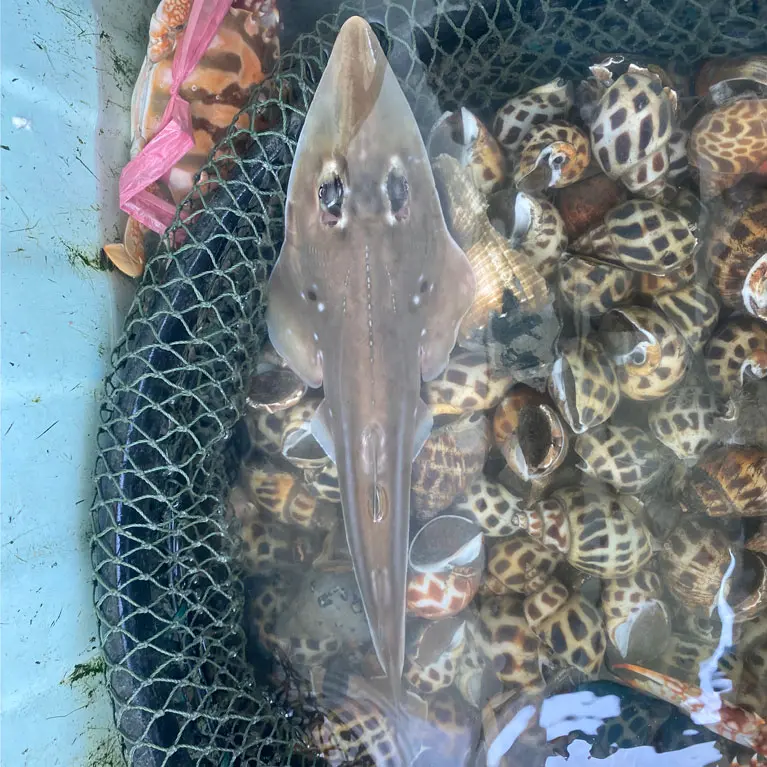Tracking shark-like rays in Taiwan
Kevin and Wei-Chuan know that information about the critical habitats used by highly endangered wedgefish and guitarfish species is needed in order to protect them. In Taiwan, in spite of these animals’ vulnerable conservation status, fisheries still catch them unintentionally and are legally allowed to retain them. This can be changed, but only with the right information. The team is developing satellite-tagging techniques to track these shark-like rays. This will help them understand their movement patterns and behaviour, and combined with genetic and ultrasound information, their work can feed into better management and protection for them.
My name is Wei-Chuan, but people called me ‘Riyar’, which means ‘ocean’ in the local language. Because I was born in a fishing village on the east coast of the island of Taiwan I love ocean life, so my classmates at primary school gave me this special name. After finishing my education in my home town in 1984, I bade farewell to my happy childhood of swimming, fishing and catching crabs in the fishing village and went to Taipei City to start a long career of studying. In 1988 I was admitted to the Pingtung Agricultural College, majoring...
I love this planet, a giant drop of salty water spinning through the universe, a teardrop of joy and pain from the gods. I am devoting my career to learning about marine wildlife so that we may conserve, or sustainably harvest, life from the seas. As a child wandering the tidal pools of Hong Kong and fishing the lakes of Michigan, I yearned to see what was in the depths. I pursued studies in biology and oceanography, learning the amazing mechanics of the ocean–atmosphere system and discovering the migrations of tuna and sharks. I am driven to learn...


Spatial ecology of Pacific guitarfishes taken in commercial fisheries
Wedgefish and guitarfish are endangered, most of them critically, according to the IUCN. We aim to use satellite and acoustic tagging to understand essential habitats for these species in Taiwan and to provide information for conservation and management by the country’s Fisheries Agency and Ocean Conservation Administration.
Although most wedgefish and guitarfish are endangered, fisheries in Taiwan take them as bycatch, and the export of fins for shark-fin soup is ongoing. It is legal to retain these species, but live release could be mandated. Tracking information is needed to protect their critical habitats. The development of wind power in waters off the western coast could create de facto protected areas, so we wish to learn if these species move into these zones.
Rhinopristiforms are in urgent need of conservation, but are poorly understood globally. The species are prized in the shark-fin trade and also consumed for meat. The conventional tagging of Rhyncobatus species in south-eastern Africa revealed both periods of residency and long-distance coastal movement. Genetic studies suggest that our present knowledge of the species’ ranges is inaccurate and much cryptic diversity may exist. Taiwan has a diversity of Rhinopristiforms, but it is likely that many species were decimated prior to the studies, as port observers noted large declines over time. Taiwan has many commercial fisheries, including bottom-contact fisheries that impact species such as wedgefish and guitarfish, but it has also recently created the Ocean Conservation Administration. Our project is well positioned to inform conservation action by this new government agency. There is a unique set of conditions in Taiwan for conducting research on wedgefish and guitarfish, as these species can be captured near to large holding tanks maintained at research laboratories, facilitating rapid transport to and from the ocean. It is possible to discover the critical habitats and movement patterns of demersal fishes with acoustic tags where there are receivers, but pop-up satellite tags are needed in other areas. A key challenge in nearly all pop-up tag studies is the early release of tags due to dart and tether failure. For years, the standard method of attaching tags to fish has been to insert a dart, but many failures have occurred. Alternative designs have been tried on a variety of species, sometimes with improved retention results.
- To develop a method to attach satellite tags based on dead market specimens. Designs will be tested using a simple machine with raspberry-pie controller/counter to tug repeatedly on the harness until it fails. Specimens will be examined and dissected to determine exact locations and causes of tissue or tether failure.
- To refine the attachment design based on how it performs on live specimens in captivity. The best designs will be applied to live specimens and evaluated with respect to tag towing behaviour. Materials will be sterilised in chlorhexidine prior to the procedure. We will seek a design that does not cause rapid oscillations and bumping against the body of the fish, or cause other issues.
- To tag wild specimens to discover their habitat and movements. We plan to use Lotek PSAT-Flex tags, which provide time series of depth, temperature and geoposition. Specimens will be placed in a cradle with a hose inserted in the mouth to provide gill irrigation. Measurements and photographs will be taken and the tether system will be attached to the dorsal area. Specimens in captivity will be transferred back to the wild, while specimens captured and tagged at sea will be released immediately after the tagging and measuring procedures.
- To conduct ultrasound tests to determine if females are pregnant. While the specimen is in the tagging cradle, the ultrasound probe will be moved along the abdomen. Any embryos present will be counted and their lengths measured.
- To genetically analyse each specimen to confirm its species and check for cryptic diversity. Each specimen will also be keyed out to species based on morphology.


